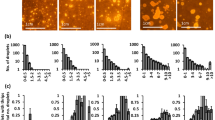Abstract
The pure herbicidal compound dinoseb-acetate (2-sec-butyl-4,6-dinitrophenyl acetate) and its commercial formulation Aretit® were tested for their effects on the spider miteTetranychus urticae L. (Acari, Tetranychidae) following post-emergence application to the host plantPhaseolus vulgaris L. under laboratory and semi-field conditions.
Mites which fed on beans treated with the pure compound produced a lower number than those feeding on untreated control plants. Mite quantity on Aretit-treated plants remained behind the control 6 days post-treatment but did not differ significantly from the control 21 days post-treatment. There were no indications for a specific sensitivity of single developmental stages. External as well as internal changes in mite morphology were not obvious independent of the kind of treatment.
Effects of herbicide application became undoubtedly obvious at the electron-microscopy level, although the pattern of cellular alterations was very unspecific. Tissue changes exceeding normal variance can be demonstrated in more than 50% of the investigated individuals of each short-term test variant. They are manifest in mitochondrial swelling and disruption, especially in cells of the midgut caeca and prosomal glands, and a disarrangement of the RER, especially in the pure-compound treatment. Cellular changes are more pronounced and polymorphological in the pure-compound test variant than in the commercial formulation variant. At 21 days post-treatment, frequency of tissue alterations exceeding normal variance was reduced, with the exception of the diluted Aretit treatment where it remained at a high level.
Consequences of cellular changes on individual and population development and dynamics ofT. urticae are estimated on the basis of dinoseb-acetate risk in agricultural practices. Results are discussed with respect to the use of electro microscopy in elucidating herbicide action, to the influence of formulation, and the need for a test system enabling a prediction of ecotoxicological actions of biocides prior to their admission for use in the field.
Similar content being viewed by others
References
Anonymous, 1984. Datensammlung zur Toxikologie der Herbizide, Deutsche Forschungsgemeinschaft/Verlag Chemie, Weinheim.
Anonymous, 1987. Pflanzenschutzmittelverzeichniss 1986/1987. II. Bemüsebau, Obstbau, Zierpflantzenbau Biologische Bundesanstalt für Land- und Forstwirtschaft, Bruanschweig, 241 pp.
Audus, L.J. (Editor), 1964. The Physiology and Biochemistry of Herbicides. Academic, New York, 555 pp.
Audus, L.J. (Editor), 1976. Herbicides: Physiology, Biochemistry, Ecology, Vol. 1. Academic, New York (2nd edition).
Brian, R.C., 1976. The history and classification of herbicides. In: L.J. Audus (Editor), Herbicides: Physiology, Biochemistry, Ecology, Academic, New York, pp. 1–54.
Eijsackers, H. and Heijmans, G., 1975. Nebenwirkungen von Herbiziden auf die Bodenfauna. Obstbau, Weinbau, 12: 176–177.
Ghadially, F.N., 1988. Ultrastructural Pathology of the Cell and the Matrix. Butterworths, London (2nd edition), 2 Vols: 1340 pp.
Godan, D., 1970. Die Wirkung von Herbiziden auf Insekten nach Untersuchungen an der Fruchtfliege (Drosophila melanogaster Meig.). Prakt. Schädlingsbek., 22: 66–69.
Hinz, B. and Daebler, F., 1980. Wirkungen von Herbiziden auf Getreideblattläuse an Winterweizen. Nachrichtenbl. Pflantzenschutzdienst DDR, 34: 214–215.
Marlow, H., 1964. Die Wirkung der in Erbsen und Buschbohnen eingesetzten Herbizide in Abhängigkeit von Standort- und Umwelteinflüssen. In: Über den Einfluß von Umweltbedingungen auf die Wirkung von chemischen Pflanzenschutzmitteln. Symp. Biol. Zentralanst. Berlin, Dtsch. Akad. Landwirtschaft, Berlin, pp. 101–112.
Mothes, U. and Seitz, K.A., 1981a. Functional microscopic anatomy of the digestive system ofTetranychus urticae (Acari, Tetranychidae). Acarologia, 22: 257–270.
Mothes, U. and Seitz, K.A., 1981b. Fine structure and function of the prosomal glands of the two-spotted spider mite,Tetranychus urticae (Acari, Tetranychidae). Cell Tissue Res., 221: 339–349.
Mothes, U. and Seitz, K.A., 1982. Action of the microbial metabolite and chitin synthesis inhibitor Nikkomycin on the miteTetranychus urticae; an electron microscope study. Pestic. Sci., 13: 426–441.
Mothes-Wagner, U., 1982. Feinstrukturelle Untersuchungen an der phytopathogenen SpinnmilbeTetranychus urticae (Acari, Tetranychidae) und zur Wirkungsweise der in der Erprobung befindlichen Nikkomycine als Bekämpfungsmittel. Dissertation, Univ. Marburg. 250 pp.
Mothes-Wagner, U., 1985. Fine structure of the ‘hindgut’ of the two-spotted spider mite,Tetranychus urticae, with special reference to origin and function. Exp. Appl. Acarol., 1: 253–272.
Mothes-Wagner, U., 1986. Comparative histopathology of the chitin synthesis inhibitors Nikkomycin X/Z, Nikkomycin Z and Polyoxin D. I. Effects on moulting, reproduction and digestion in the spider miteTetronychus urticae. Pestic. Sci. 17: 607–620.
Mothes-Wagner, U. and Seitz, K.A., 1984. Ultrahistology of oogenesis and vitellogenesis in the two-spotted spider miteTetranychus urticae. Tissue Cell, 16: 179–194.
Mothes-Wagner, U., Wagner, G., Reitze, H.K., and Seitz, K.A., 1984. A standardized technique for the in toto resin embedding and precipitate-free staining of small specimens covered by strong protective outer surfaces. J. Microsc. (Oxford), 134: 307–313.
Mothes-Wagner, U., Reitze, H.K., Ebersold, B. and Seitz, K.A., 1990a. Entwicklung eines Modellökosystems zur Beurteilung von Pflanzenschutzmitteln. UBA-Forschungsbericht 126 0507, Marburg, 22 pp.
Mothes-Wagner, U., Reitze, H.K. and Seitz, K.A., 1990b. Environmental actions of agrochemicals. 1. Side-effects of the herbicide 3-amino-1,2,4-triazole on a laboratory acarine/hostplant interaction (Tetranychus urticae/Phaseolus vulgaris) as revealed by electron microscopy. Exp. Appl. Acarol., 8: 27–40.
Müller, F., 1986. Phytopharmakologie, Ulmer, Stuttgart, 228 pp.
Mullin, C.A. and Croft B.A., 1983. Host-related alterations of detoxification enzymes inTetranychus urticae (Acari, Tetranychidae). Environ. Entomol., 12: 1278–1282.
Perkow, W., 1983/1985. Wirksubstanzen der Pflanzenschutz-und Schädlingsbekämpfungsmittel (2. Aufl.). Paul Parey, Hamburg.
Rautapäa, J., 1972. Effect of herbicides and chlormequatchlorid on host-plant selection and popular growth ofMacrosiphum avenae (F.) (Hom., Aphididae). Ann. Agric. Fenn., 11: 135–140.
Réz, G., 1986. Electron microscopic approaches to environmental toxicity. Acta Biol. Hung., 37: 31–45.
Starý, P. and Beneš, V., 1973. Effects of Aretit, a herbicide and insecticide compound, on the pea aphid,Acyrthosiphon pisum, and associated parasites, Acta Entomol. Bohemoslov., 70: 168–173.
Author information
Authors and Affiliations
Rights and permissions
About this article
Cite this article
Mothes-Wagner, U., Reitze, H.K. & Seitz, KA. Environmental actions of agrochemicals 2. Histological effects of the herbicide/insecticide dinoseb-acetate (2-sec-butyl-4,6-dinitrophenyl acetate) on the spider miteTetranychus urticae (Acari: Tetranychidae) reared on herbicidetreatedPhaseolus vulgaris . Exp Appl Acarol 9, 289–310 (1990). https://doi.org/10.1007/BF01193435
Accepted:
Issue Date:
DOI: https://doi.org/10.1007/BF01193435




